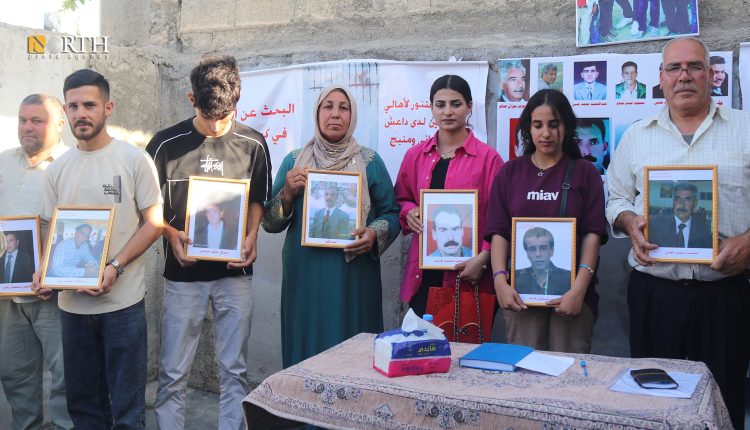
By Fattah Issa
KOBANI, Syria (North Press) – The Mushteh Nour Association for Families of ISIS Detainees held a remembrance event at its headquarters in Kobani marking 11 years since the disappearance of hundreds of civilians kidnapped by the Islamic State (ISIS) in the cities of Kobani and Manbij, northern Syria.
According to human rights documentation, ISIS abducted about 580 individuals from Kobani and its surrounding countryside between 2013 and 2014. Despite the group’s territorial defeat in Baghuz town, eastern Syria in 2019, the fate of these individuals remains unknown.
“They were children when their father was taken…”
With a voice filled with sorrow and persistent hope, Jalila Ali from Kobani recounted the abduction of her two brothers by ISIS in 2013.
“They were children when their father was taken,” she said, referring to her brother’s children. “Now they are in university, still waiting for any news.”
Her elder brother, engineer Ahmad Mesho Ali (b. 1969), was abducted near the area between Raqqa and Tel Abyad in 2013. Her younger brother, Idris Mesho Ali (b. 1980), was taken from his home in Raqqa at 10 p.m. the same year.
According to the Violations Documentation Center in Northern Syria, ISIS abducted 160 civilians from Kobani in February 2014 as they traveled toward the Semalka border crossing with the Kurdistan Region of Iraq. The group was intercepted and taken near the village of Alia, west of Hasakah.
On Sep. 15, 2014, ISIS launched a major assault on Kobani, deploying significant force in an attempt to seize the city and its outskirts.
Ali emphasized that her family has suffered deeply: their mother died heartbroken, and the children grew up fatherless. “We call on the new government to prioritize humanitarian issues,” she said. “Their children and families are still hoping to be reunited with them.”
12 teachers still missing
Bakri Ali, another Kobani resident, shared the story of his brother Ismat Ali, a former elementary school principal. He was kidnapped along with 11 teachers on May 7, 2014, at the Qaraqozaq Bridge checkpoint while traveling to Aleppo to collect their salaries.
“They were transferred to the city of Manbij,” Bakri told North Press, citing testimony from released prisoners. “We tracked their movements and learned they were moved to an area between Manbij and al-Bab.”
He said the hostages were eventually transferred to a school-turned-prison in the village of Dibsi Afnan. One released detainee reported that the teachers were still alive at the time.
Bakri added that up until 2017, they had received indications that his brother was alive. However, after the Syrian Democratic Forces (SDF) liberated Tabqa and Raqqa, all communication was lost.
Families now appeal to both the Autonomous Administration of North and East Syria (AANES) and the new Syrian government to determine whether their loved ones are dead or still alive.
580 civilians abducted by ISIS from Kobani alone
Mahmoud Zaito, an official with the Mushteh Nour Association and brother of one of the missing, said the organization has documented the names of 580 civilians abducted by ISIS from Kobani. Many were residing in Kobani, Manbij, and Raqqa at the time of their disappearance.
The Mushteh Nour Association was established in 2019 by the families of abductees and later registered with the AANES.
Zaito said the goal of the recent event was to keep families connected and informed about any updates regarding their loved ones. Many of the abductions were group kidnappings. For instance, 147 individuals were abducted from 12 taxi vans near al-Mabroukah while en route to Iraq.
Teachers were kidnapped on the road to Aleppo. In Manbij alone, 72 Kurdish people were arrested from their homes. Others were taken individually—some while riding motorcycles, others while herding sheep.
“All those we have documented as abducted are civilians,” Zaito said. “None were military or involved in combat.”
No confirmed evidence has surfaced regarding their deaths, he added, which is why their motto remains: “We are searching for a needle in a haystack.” He believes there is a 70-80 percent chance that many abductees are still alive.
Zaito confirmed that the association is in contact with international organizations. Amnesty International has published the names of 13 and later 17 abductees, and the association is also cooperating with the U.N. Human Rights Office to uncover the fate of the missing.
In June 2023, the U.N. General Assembly approved the establishment of an independent institution tasked with revealing the fate of the missing and forcibly disappeared in Syria.
According to various U.N. estimates, around 100,000 people have gone missing in Syria since 2011, though actual figures are believed to be significantly higher.
